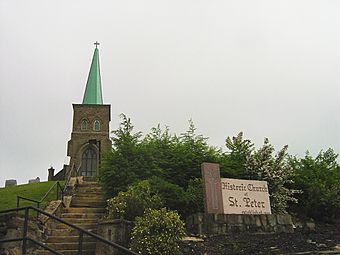St. Peter's Church (Brownsville, Pennsylvania) facts for kids
Quick facts for kids |
|
|
The Historic Church of St. Peter Roman Catholic Church
|
|

The Historic Church of St. Peter in Brownsville, Pennsylvania, as seen in June 2009.
|
|
| Location | Church St., Brownsville, Pennsylvania |
|---|---|
| Area | 0.8 acres (0.32 ha) |
| Built | 1843 |
| Architect | Mr. Crisp |
| Architectural style | Gothic Revival |
| NRHP reference No. | 80003494 |
| Added to NRHP | October 15, 1980 |
The Historic Church of St. Peter is a very old Roman Catholic church located in Brownsville, Pennsylvania. It is part of the Diocese of Greensburg. This church is famous for its long history and beautiful design. It is the oldest parish in Western Pennsylvania that has been in use without stopping.
Contents
History of the Church
The First Religious Service
A very important event happened on this spot even before the church was built. On July 1, 1754, during the French and Indian War, French soldiers were on their way to fight the British at Fort Necessity. They stopped here by the Monongahela River.
Their chaplain, a priest named Rev. Denys Baron, led them in a prayer for victory. This is believed to be the first Christian religious service held west of the Allegheny Mountains. One of the church's beautiful stained-glass windows shows this historic moment.
Building a Landmark
The church building we see today was built in 1843. At that time, many Irish families were moving to the area. They wanted to build a church that would stand out. They chose a style called Gothic Revival, which was popular for grand churches.
The church was built on a hill overlooking the town, so it could be seen from all around. It was constructed with rough stone from the nearby river, connecting it to the local landscape. In 1980, the church was added to the National Register of Historic Places because of its importance.
Designed to be a Cathedral
The people who built St. Peter's had big dreams. They believed their town, Brownsville, would become more important than Pittsburgh. They thought it would be chosen as the center of a new church district, or episcopal see.
Because of this, they designed the church to be a cathedral, which is a bishop's main church. For example, the pulpit (a raised platform for preaching) is on the left side of the altar, which is typical for a cathedral. There is also a crypt, or underground room, with space for bishops to be buried.
Unique Features of St. Peter's
The Stained-Glass Windows
The church's stained-glass windows are famous for their beauty. They use 32 different shades of blue glass to tell stories from Catholic history in the area, from the French soldiers in 1754 to the church's founding in 1843.
The Cemetery with Heated Graves
St. Peter's has a very unusual cemetery. It was once featured in the popular show Ripley's Believe It or Not because it was known as the only cemetery in the world with heated graves.
This happened because the building that housed the church's boiler was across the street. The hot pipes that carried heat to the church ran underground through the cemetery. These pipes warmed the ground so much that they could even melt snow on top of some of the graves.
Notable Burials
- The parents of James G. Blaine are buried in the cemetery. Blaine grew up nearby and became a famous politician. He served as a U.S. Senator and Secretary of State. He also ran for president in the 1884 United States presidential election but lost to Grover Cleveland.
Gallery





